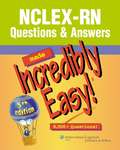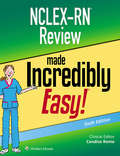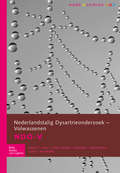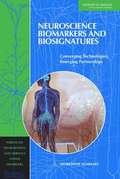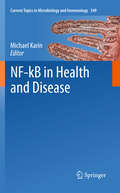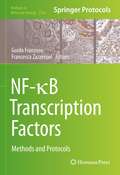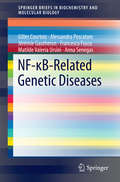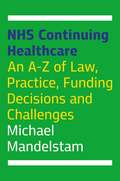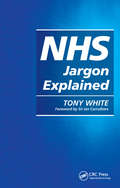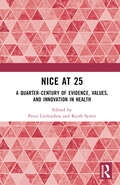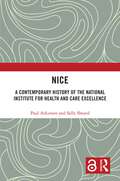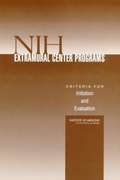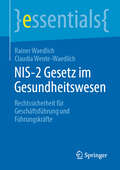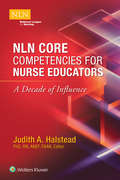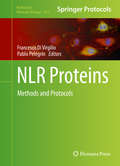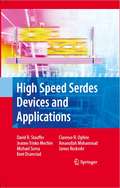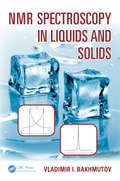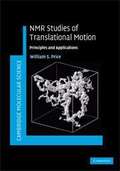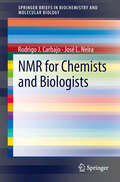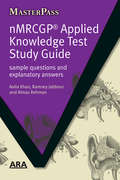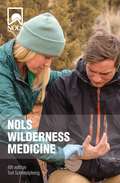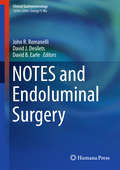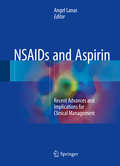- Table View
- List View
NCLEX-RN Questions and Answers (5th Edition)
by Springhouse Publishing Company Staff Lippincott Williams Wilkins StaffPractice questions are the best way to prepare for success on the exam - and only one book makes practicing for NCLEX-RN® Incredibly Easy! NCLEX Q&A Review Made Incredibly Easy provides 6,500 total questions in the text and online - more than ever before! Completely updated to reflect the latest test plan and featuring the high quality questions that help students pass the NCLEX exam, the fifth edition features all question types appearing on the test - including audio and graphic option questions. Page after page of study questions with clear rationales make for effective, efficient study sessions, and the Incredibly Easy approach promotes knowledge retention while decreasing study anxiety. You'll actually enjoy learning, stay motivated, and improve your performance on the licensing exam! Take the stress out of studying with: More practice questions than ever before! 3,000 practice questions included in the text Over 3,000 NCLEX-style practice questions on the companion website, including audio questions and graphic option questions.
NCLEX-RN Review Made Incredibly Easy!: Made Incredibly Easy (Incredibly Easy! Series®)
by Candice RomeNCLEX-RN REVIEW MADE INCREDIBLY EASY, 6E is designed to help nursing students prepare to take the licensing examination. The book blends critical content review in an easy-to-follow and bulleted format, pharmacology tables that summarize core medication information, and thousands of questions covering all the Client Need categories of NCLEX and the major content areas of pre-licensure programs. The product reviews core curriculum concerns and more than 3,000 questions that prompt active learning and higher-order thinking. Questions align with the National Council of State Boards of Nursing (NCSBN) 2019 RN test plan and are written in the style used on the licensing examination. Other features include the use of all the types of alternate-format questions found on the licensing examination, detailed rationales for both correct and incorrect answers, and information about the NCLEX-RN. An accompanying code gives student access to a 7-day free trial of Lippincott PassPoint-RN.
NDO Nederlands dysarthrieonderzoek handleiding
by Hanneke Kalf Simone Knuijt Bert de SwartHet NDO is een instrument waarmee de diagnose ‘dysartrie’ gesteld kan worden. Daarnaast kan met het instrument het type dysartrie en de ernst ervan worden vastgesteld. In Nederland is momenteel geen betrouwbaar en valide dysartrieonderzoek beschikbaar. Met het verschijnen van het NDO is hierin verandering gekomen. Het NDO is een gestandaardiseerd, valide en betrouwbaar instrument dat kan bijdragen aan dat zich richt op het diagnosticeren van de dysartrie. Het instrument draagt daarmee bij aan een betere basis voor logopedische therapie. Het NDO onderzoekt het type en de ernst van de dysartrie met behulp van gestandaardiseerde spreekopdrachten. Alle aspecten van de spraak, te weten adem, fonatie, articulatie, nasale resonantieen prosodie worden met deze opdrachten hiermee in kaart gebracht, zodat de logopedist een diagnose kan stellen. HMet het NDO is bedoeld voor kunnen patiënten worden onderzocht bij wie een vermoeden bestaat dat er sprake is van een dysartrie. Het instrument is geschikt om af te nemen zowel in de acute, de revalidatie en de chronische fase.
NEUROSCIENCE BIOMARKERS AND BIOSIGNATURES: Converging Technologies, Emerging Partnerships
by Institute of Medicine of the National AcademiesBiomarkers, or biological markers, are quantitative measurements that offer researchers and clinicians valuable insight into diagnosis, treatment and prognosis for many disorders and diseases. A major goal in neuroscience medical research is establishing biomarkers for disorders of the nervous system. Given the promising potential and necessity for neuroscience biomarkers, the Institute of Medicine™ Forum on Neuroscience and Nervous System Disorders convened a public workshop and released the workshop summary entitled Neuroscience Biomarkers and Biosignatures: Converging Technologies, Emerging Partnerships. The workshop brought together experts from multiple areas to discuss the most promising and practical arenas in neuroscience in which biomarkers will have the greatest impact. The main objective of the workshop was to identify and discuss biomarker targets that are not currently being aggressively pursued but that could have the greatest near-term impact on the rate at which new treatments are brought forward for psychiatric and neurological disorders.
NF-kB in Health and Disease
by Michael KarinNearly 25 years of intensive research have uncovered many diverse functions for the dimeric transcription factor known as NF-kappaB (nuclear factor-kappaB). NF-kappaB affects most aspects of cellular physiology--from immunity and inflammation to apoptosis, cell survival, growth, and proliferation
NF-κB Transcription Factors: Methods and Protocols (Methods in Molecular Biology #2366)
by Guido Franzoso Francesca ZazzeroniThis detailed book serves as a systematic examination of the analytical methods to study the transcription factor NF-κB in physiology and disease. It provides an up-to-date guidebook to navigate both conventional and highly specialized methods to detect and analyze the different signaling pathways of NF-κB activation and contextualize them within organismal physiology and disease pathogenesis, using genetic and biochemical techniques and some of the most advanced computational and systems biology methods. Additionally, the volume includes several examples of approaches utilized by leading experts in the NF-κB field to analyze and modulate NF-κB signaling in specific physiological and disease contexts, along with some of the most promising approaches to pharmacologically target the NF-κB pathway in human disease. Written for the highly successful Methods in Molecular Biology series, chapters include introductions to their respective topics, lists of the necessary materials and reagents, step-by-step, readily reproducible laboratory protocols, and tips on troubleshooting and avoiding known pitfalls. Authoritative and practical, NF-κB Transcription Factors: Methods and Protocols is an up-to-date guide intended for both basic and translational scientists who are working in the dynamic NF-κB field.
NF-κB-Related Genetic Diseases
by Gilles Courtois Alessandra Pescatore Jérémie Gautheron Francesca Fusco Matilde Valeria Ursini Anna SenegasThis book presents the diverse clinical, cellular and molecular manifestations of NF-KB-related genetic diseases. It shows that studying patient-related pathologies affecting the components of the NF-KB signaling pathway offers the opportunity to understand the various functions of NF-KB in humans, complementing studies performed with mouse models. In addition, people treating those patients acquire a deeper understanding of the molecular basis of the pathophysiological processes.
NHS Continuing Healthcare: An A-Z of Law, Practice, Funding Decisions and Challenges
by Michael MandelstamThis authoritative guide to the law of continuing healthcare provides clarity on a contentious issue for those in long-term care: which adults are eligible for full NHS funding, as opposed to self-funded social care.Written by seasoned legal expert Michael Mandelstam, it provides practitioners with clear information on both the letter and spirit of the law, written in an accessible style suitable for a wide range of health and social care practitioners. The book gives all the need-to-knows in a handy A-Z format for quick reference, including key legal rules, guidance and case law.It contains also an extended analysis, with detailed evidence, of NHS continuing healthcare over the last 30 years up to the present. This is critical in order to understand why the rules are so complex, confusing and sometimes disregarded, and why decisions can seem counter-intuitive, unfair and difficult to challenge.The book is essential reading to assist the making of decisions that are fair, lawful and transparent.
NHS Jargon Explained (Radcliffe Ser.)
by Tony WhiteWhy is TALOIA bandied about in clinics and on wards? Who - or what - is DAN? If someone mentioned Practice Based Commissioning or the Standardised Mortality Ratio, would you understand what they meant? Like any specialised area, the NHS generates clouds of terms, acronyms and shorthand vital for those in the know but virtually impenetrable to outsiders or those new to healthcare. New acronyms or the jargon of areas outside their immediate expertise can be utterly baffling even to old hands. This book brings together an up-to-date, clearly explained glossary of specialised terminology and acronyms used at all levels of the NHS, from primary care surgeries to hospital wards, admin departments to executive boardrooms. It is essential reading for workers in the NHS at all levels, including managers, administrators and clinical professionals, and for managers and staff at commercial companies working with the NHS. Specialty registrars and consultants can also find this information, and much more, in The Doctor's Handbook Parts 1 and 2, by the same author. NHS Jargon Explained will also be of interest to campaigners, patient interest groups, researchers and journalists, and patients and their relatives may also find it useful and enlightening! 'There is no more important time than now to have a quick reference guide that enables the greatest number of people to quickly come to terms with the language of the health service. I welcome this book for being both comprehensive and concise'- from the Foreword by Sir Ian Carruthers
NHS Reform and Health Politics in the UK: Revolution, Counter-Revolution and Covid Crisis
by Calum PatonThis book provides an original analysis of the trajectory of health policy reform in the United Kingdom from the beginning of the ‘Thatcher reforms’ in the 1980s right up to the latest changes in England in 2022. Rooted in political science and health policy analysis, it tackles key arguments around the ‘new integration’ of the NHS since 2015, what the new and emerging NHS structure represents, the UK’s poor response to the Covid-19 crisis, and the future threat to a comprehensive public NHS. It includes significant new material on what has happened since 2015, such as the politics of the Covid-19 pandemic, the effects of Brexit, and the conundrum of ‘social care’. The book is a scholarly and polemical analysis from an expert who has studied the politics of health services for more than forty years. It will be a key resource for students, academics and policy makers.
NICE at 25: A quarter-century of evidence, values, and innovation in health
by Keith Syrett Peter LittlejohnsMarking its 25th anniversary, this fascinating collection examines the pioneering work of the National Institute for Health and Care Excellence (NICE).Setting standards for the delivery of healthcare, issuing guidance on public health, and assessing and making recommendations on health technologies, NICE has attracted widespread international attention, emulation, and comment. The authors in this collection, drawn from a broad range of disciplinary backgrounds, offer analysis of key issues which have informed NICE’s work, from the principles of health economics, to patient engagement, to the legal basis on which NICE operates.Covering many of the most important themes within contemporary debates on health policy and management today, this insightful collection will interest students and researchers, as well as policy makers in the field.
NICE: A Contemporary History of the National Institute for Health and Care Excellence
by Paul Atkinson Sally SheardIt may seem as if the National Institute of Health and Care Excellence (NICE) has always been part of the UK’s health and social care landscape. But this fascinating book charts the evolution of NICE from its origins 25 years ago, as well as how this development illustrates many of the key themes effecting health care today.In a period of rapid medical and technological advance, NICE has been both a gatekeeper to ensure that health care resources are spent where they are needed most, and a promoter of patient access to the best new technologies. Through a detailed history, the authors show how NICE’s remit grew from health care to public health to social care, advancing the use of evidence-based policy making and health economics as it did so. Playing a key role in ethical debates which often made the news, NICE also re-aligned the relationship between patients, politicians and the pharmaceutical industry.Written by two of the leading scholars in the field, this fascinating history also situates NICE in an international context, where it is often seen as a model to follow. It will be key reading for students and researchers in the fields of health and social care and health policy, as well as professionals and interested general readers.The Open Access version of this book, available at http://www.taylorfrancis.com, has been made available under a Creative Commons Attribution-Non Commercial-No Derivatives (CC BY-NC-ND)] 4.0 license.
NIH Extramural Center Programs: Criteria for Initiation and Evaluation
by Institute of Medicine of the National AcademiesGrants for research centers located in universities, medical centers, and other nonprofit research institutions account for about 9 percent of the National Institutes of Health budget. Centers are popular because they can bring visibility, focus, and increased resources to bear on specific diseases. However, congressional debate in 2001 over proposed legislation directing NIH to set up centers for muscular dystrophy research highlighted several areas of uncertainty about how to decide when centers are an appropriate research mechanism in specific cases. The debate also highlighted a growing trend among patient advocacy groups to regard centers as a key element of every disease research program, regardless of how much is known about the disease in question, the availability of experienced researchers, and other factors. This book examines the criteria and procedures used in deciding whether to establish new specialized research centers. It discusses the future role of centers in light of the growing trend of large-scale research in biomedicine, and it offers recommendations for improving the classification and tracking of center programs, clarifying and improving the decision process and criteria for initiating center programs, resolving the occasional disagreements over the appropriateness of centers, and evaluating the performance of center programs more regularly and systematically.
NIS-2 Gesetz im Gesundheitswesen: Rechtssicherheit für Geschäftsführung und Führungskräfte (essentials)
by Rainer Waedlich Claudia Wente-WaedlichDie ausufernde Bürokratisierung überfordert Ärzte und Gesundheitsmanager in der ambulanten und stationären Versorgung durch immer höhere Verpflichtungen und Risiken. Die neue EU-Gesetzgebung mit dem NIS-2 Umsetzungsgesetz für konsequente Informationssicherheit und hohe persönliche Risiken für Führungskräfte stellt einen Paradigmenwechsel im Gesundheitswesen dar. Das Buch bietet Hilfe zur Selbsthilfe für alle, die Verantwortung in Krankenhäusern, Kliniken, Praxen sowie Pflegeeinrichtungen tragen. Ärzte können mit dem Wissen, das durch das Buch vermittelt wird, wieder ihre eigene Organisation beherrschen.
NLN Core Competencies for Nurse Educators: A Decade of Influence
by Judith HalsteadPublisher's Note: Products purchased from 3rd Party sellers are not guaranteed by the Publisher for quality, authenticity, or access to any online entitlements included with the product. NLN Core Competencies for Nurse Educators: A Decade of Influence Judith A. Halstead, PhD, RN, ANEF, FAAN, Editor Thirteen years after initial publication, the NLN Core Competencies for Nursing Educators continue to guide the development of graduate nursing programs, define the roles and responsibilities of nurse educators, and provide a framework for ongoing research in identifying the knowledge, skills, and attitudes essential to preparing a qualified nursing workforce. NLN Core Competencies for Nurse Educators: A Decade of Influence revisits these critical guidelines through a contemporary lens that underscores their ongoing influence and offers valuable insight into how they will help shape the evolution of the nurse educator role. Whether you’re a practicing nurse educator or pursuing a career in nursing education, you’ll gain a better understanding of the theoretical foundation behind this landmark literature and learn how to best use it to successfully navigate the complex role of today’s nursing faculty. “Nurse educators, grounded by the current evidence about the role of the nurse educator, will ensure that the next generation of students is prepared to provide interdisciplinary, patient-focused, safe, and high-quality care.” Diane M. Billings, EdD, RN, ANEF, FAAN Chancellor’s Professor Emeritus Indiana University School of Nursing, Indianapolis
NLR Proteins
by Francesco Di Virgilio Pablo PelegrínThis volume providesa sound basis for the molecular investigation of NLR function in health anddisease. Chapters focus on of innate immune receptors, "atypical"inflammasomes, biochemical and novel bioluminescencetechniques for the measurement of IL-1b,bioluminescent probe, biochemical and microscopytechniques, techniques to measure caspase-1 activation, cellfree systems for the study of inflammasome function, and inflammasomeactivation. Written in the highly successful Methodsin Molecular Biology series format, chapters include introductions to theirrespective topics, lists of the necessary materials and reagents, step-by-step,readily reproducible laboratory protocols, and tips on troubleshooting andavoiding known pitfalls. Authoritativeand cutting-edge, NLR Proteins: Methodsand Protocols aims to ensure successful results in the further study ofthis vital field.
NMDA Receptor Protocols
by Min LiMin Li and a panel of hands-on experimentalists detail state-of-the-art molecular techniques for studying NMDA ligand-gated ion channels and developing assays for nontherapeutic lead selection. The topics range from cDNA cloning to in vitro and in vivo investigation of the channel complex in the mammalian brain. Additional topics include the biochemical analysis of the channel protein and the construction of various heterologous systems for both basic research and high throughput screens (HTS) for pharmaceutical chemicals. Although the focus is on NMDA receptors, the methods are applicable to other ligand-gated ion channels and with some modification may be extended to related membrane signaling receptors. NMDA Receptor Protocols offers today's scientists powerful methods for basic research on NMDA receptor structure and function, as well as enormous opportunities for clinical investigation toward the development of novel bioactive compounds.
NMR Spectroscopy in Liquids and Solids
by Vladimir I. BakhmutovNMR Spectroscopy in Liquids and Solids provides an introduction of the general concepts behind Nuclear Magnetic Resonance (NMR) and its applications, including how to perform adequate NMR experiments and interpret data collected in liquids and solids to characterize molecule systems in terms of their structure and dynamics.The book is composed of t
NMR Spectroscopy of Biological Solids
by A. RamamoorthyOver the past decade, a myriad of techniques have shown that solid-state nuclear magnetic resonance (NMR) can be used in a broad spectrum of applications with exceptionally impressive results. Solid-state NMR results can yield high-resolution details on the structure and function of many important biological solids, including viruses, fibril-formin
NMR Studies of Translational Motion
by William S. PriceTranslational motion in solution, either diffusion or fluid flow, is at the heart of chemical and biochemical reactivity. Nuclear Magnetic Resonance (NMR) provides a powerful non-invasive technique for studying the phenomena using magnetic field gradient methods. Describing the physical basis of measurement techniques, with particular emphasis on diffusion, balancing theory with experimental observations and assuming little mathematical knowledge, this is a strong, yet accessible, introduction to the field. A detailed discussion of magnetic field gradient methods applied to Magnetic Resonance Imaging (MRI) is included, alongside extensive referencing throughout, providing a timely, definitive book to the subject, ideal for researchers in the fields of physics, chemistry and biology.
NMR for Chemists and Biologists
by Rodrigo J Carbajo Jose Luis NeiraThis book intends to be an easy and concise introduction to the field of nuclear magnetic resonance or NMR, which has revolutionized life sciences in the last twenty years. A significant part of the progress observed in scientific areas like Chemistry, Biology or Medicine can be ascribed to the development experienced by NMR in recent times. Many of the books currently available on NMR deal with the theoretical basis and some of its main applications, but they generally demand a strong background in Physics and Mathematics for a full understanding. This book is aimed to a wide scientific audience, trying to introduce NMR by making all possible effort to remove, without losing any formality and rigor, most of the theoretical jargon that is present in other NMR books. Furthermore, illustrations are provided that show all the basic concepts using a naive vector formalism, or using a simplified approach to the particular NMR-technique described. The intention has been to show simply the foundations and main concepts of NMR, rather than seeking thorough mathematical expressions.
NMRCGP Applied Knowledge Test Study Guide: Sample Questions and Explanatory Answers
by Aalia Khan Ramsey Jabbour Almas RehmanAs three young, dynamic GPs working in London we realised that there was a dearth of well written up-to-date MCQ revision guides with satisfactory explanations. Since we all achieved distinctions in the MRCGP exam we believed we could incorporate our revision notes on hot topics to develop a high-quality contemporary MCQ resource...This comprehensive revision aid covers the entire nMRCGP syllabus over four exam papers. It's the most up-to-date guide available for the new exam and, alongside its online resources, provides a wide-ranging tool for candidates. It's easy to read and comprehend, and exam topics are grouped in the index to make for easy reference and further study.
NOLS Wilderness Medicine (Sixth Edition)
by Tod SchimelpfenigThe sixth edition of the best-selling NOLS Wilderness Medicine includes all the key first-aid information that made previous editions so valuable, now updated throughout with the latest medical recommendations. This guide is used on NOLS courses to train outdoor leaders to prevent, recognize, and treat common medical problems and to stabilize severely ill or injured patients for evacuation. A vital resource for outdoor enthusiasts, this book covers fundamental topics in first aid from the unique perspective of NOLS. <p><p> This book covers fundamental topics in first aid, including patient assessment, shock, soft tissue injury, burns, fractures and dislocations, and chest, head, and abdominal injury. It explains how to handle environmental problems posed by heat, cold, water, altitude, and poisonous plants and animals. <p> Also discussed are issues related to expedition medicine as well as leadership, teamwork, and communication for rescue groups. While risk can be minimized through good judgment, skills, and experience, being prepared for emergencies in the wild is an essential component of good outdoor leadership.
NOTES and Endoluminal Surgery
by John R. Romanelli David J. Desilets David B. EarleThis volume provides a broad introduction in Natural Orifice Transluminal Endoscopic Surgery (NOTES) to the novice, as well as a comprehensive and up-to-date review of the major areas of research in this field for those already performing NOTES. Designed as stand-alone treatises on each particular topic, the chapters are arranged around management of esophageal motor disorders, gastric closure, transgastric NOTES, transvaginal procedures, transrectal NOTES and natural orifice colorectal surgery, and also novel natural orifice techniques that go beyond routine diagnostic and therapeutic endoscopy. Written by experts in the field, NOTES and Endoluminal Surgery is a valuable resource for gastroenterologists and surgeons working in the field of NOTES.
NSAIDs and Aspirin
by Angel LanasThis volume is a state-of-the art resource on the recent advances and clinical management of NSAIDs and aspirin. The text provides a thorough overview of NSAIDS and aspirin, reviewing such topics as pharmacology and mechanisms, clinical effects, and the safety and efficacy of these drugs. It also focuses on the effect of the drugs on the cardiovascular system and in the prevention of GI cancer. Practical recommendations for a safe prescription of NSAIDs are also included. Written by experts in the field, NSAIDs and Aspirin: Recent Advances and Implications for Clinical Management is a comprehensive text of great value to gastroenterologists, rheumatologists, cardiologists, oncologists, orthopedists, trauma and internal medicine specialists.
